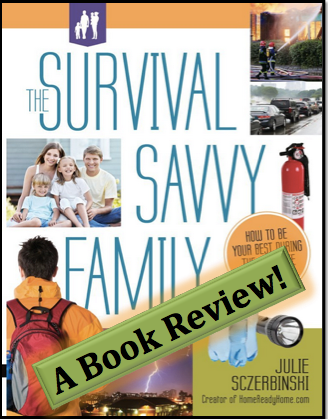With all the media attention to being prepared for emergencies: whether natural or man-made, many people are looking for ways they can survive large or small scale disasters. Even something as simple as losing a job or unexpected medical situation can be considered a disaster! Like most people today, they go to the internet to research information on how to be more ‘prepared.’ What they usually find are servers full of fear mongers, varying opinions, and people trying to get you to spend thousands of dollars on gear they don’t really need. It can be difficult to find all the information you need in one place!
Julie Sczerbinski of HomeReadyHome.com has just released a “The Survival Savvy Family” that takes a lot of the guess work (and hours spent researching for good information) out of the equation so you can get ‘to it’ right away. I know when we started our journey to being more self-reliant and sustainable, it was extremely overwhelming and I found myself frustrated more often than not. I spent hours online, trying to glean kernels of information that applied to me. I didn’t have the money to spend on a 6 month supply of freeze dried food (honestly, who does?) and I wanted to learn how to do things for myself. I had to make my own path and struggle through many trials and errors but thanks to this book, YOU don’t have to!
The Nitty Gritty
When I looked at the table of contents, my mind was blown. Having to try and figure out game plans for all of the levels of preparedness on my own, I couldn’t believe how thorough Julie had gotten. Almost everyone thinks about the financial and food aspect of being prepared and surviving a disaster but unless you are mired into the lifestyle of prepping, survivalism, or homesteading, there are many things the average person would miss out. Not with this book! It covers emergency plans, kits, and having medical readiness. It has sections that cover talking with your children about emergencies and what to do. What if something happens while you are out and about?
I personally cannot stand sites or literature that preys upon people’s fears and imagination. Especially those that get you all worked up with the intent of selling you something you don’t need. Say you live in ‘tornado alley.’ Yes, an electro-magnetic pulse could wipe out all electronics in an area. But what is more likely: an EMP or a twister? Planning for the tornado is more prudent and logical. That is the angle this book takes and I for one, really appreciate it. The tone for the whole book is set in the introduction shared here with permission from the author:
“If my family had to evacuate, where would we go?
How would we have managed if our tap water was contaminated?
What would I have fed the kids if we wee stuck on the Atlanta interstate for ten hours like thousands were during a winter storm?
What exactly goes into an emergency kit?”
How does this book differ from others with a similar subject? LOTS! First, the style of writing is very comfortable and easy to read. You don’t need a dictionary to understand what they are talking about. If there are more technical terms, they are explained. Also, there are check lists and step by step instructions on how to handle different situations you may find yourself in.
The focus of this book is on realistic things that can and do happen. Not a meteor hitting the earth, no alien invasions, and certainly not a zombie apocalypse. Instead, it covers fires, home invasions, storms, and the decision to stay in place or get out to a safer location. With realistic, very down to earth perspective, I think you will find “The Survival Savvy Family” to be as refreshing a read as I did. Even for someone who thought she had a pretty good grasp on preparedness, I learned where I needed to improve and which areas I could leave on maintenance mode. I highly recommend this book for anyone, not just families!
You can get your own copy in either Kindle or paperback here!




